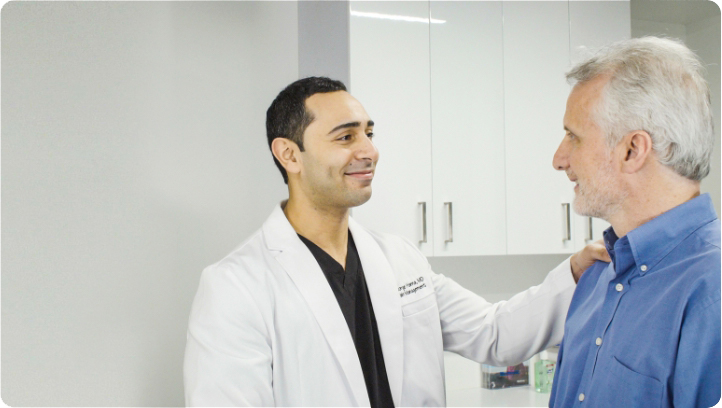Back Pain Doc in Clifton Reveals 6 Ways to Keep a Correct Posture
July 31, 2021
Standing up straight to look your best is only one aspect of good posture and it is also critical to your long-term health. Ensuring you hold your body correctly, both when you’re moving and standing, can help you avoid discomfort, injuries, and other health issues.
To put it simply, posture means the way you hold your body and it is divided into two types: dynamic posture (when moving) and static posture (when standing, sitting, sleeping). Both are equally as important and can lead to back pain if neglected.
The positioning of your spine is crucial for optimal posture. The spine has three natural curves: at the neck, in the center, and in the lower back. Good posture should keep these curves but not accentuate them. Ideally, your head should sit right above your shoulders, not pushed forward, and your shoulders should align with your hips.
Physical therapy and minimally invasive treatment can be great treatments in alleviating neck, back, and joint pain. However, in many cases, these problems can be solved by doing something as little as correcting your posture. This is why we asked Dr George Hanna, a board-certified back pain doc in Clifton to reveal a few ways in which you can correct your posture before having to try more complex therapy.

Make use of a lumbar roll
Adding extra back support with the use of a lumbar roll is one of the simplest techniques to achieve and maintain a correct sitting posture. These rolls are inexpensive circular pillows that may be used when sitting to help preserve the forward curvature your lower back naturally has.
This curvature, known as lumbar lordosis, is necessary for relieving tension on the back muscles, joints, and discs. Lumbar rolls are available for purchase from many physical therapists, medical stores, or you can easily order one online. Your physical therapist can demonstrate the proper way to utilize your lumbar roll, so be sure to ask them at your next appointment.
Try a slouch overcorrect manoeuvre
The slouch overcorrect exercise is a basic technique for training your body to find and keep proper posture. The exercise entails gradually moving from a slouched to an overcorrected posture. Once you go through the overcorrection, which is an exaggerated move, slightly relax your body, and you will reach the correct posture.
Practicing the slouch overcorrect manoeuvre can help train your body to naturally detect good posture. Your muscles have memory, and the more often you place yourself in ideal posture, the better your body will be at finding it.
Do sculptural stabilization exercises
Through proper exercise recommended by your physical therapist, you can correct your posture and improve the health of your back. To better control your posture, you need to do stretches and exercises that strengthen the muscles around your shoulder blades.
This can be easily achieved by doing some simple stretches, such as prone T, I, or Y, to aid with the improvement of neuromuscular activation. In simpler terms, this means training your muscle to get used to support your back in the correct posture.
Use the good old alarm
Setting an alarm while working is a simple yet effective way to educate your body to maintain proper posture. Because let’s be honest, how many times have you sat at your computer with excellent posture just to start hunching and slouching in a matter of minutes?
Alarms are available on many PCs and devices. Simply set a timer or alarm that repeats every 20 minutes. When your alarm goes off, correct your posture, click the snooze button, and go back to what you were doing. As you improve at keeping proper posture, you can set alarms further apart. Even when you feel you are in control of your posture, it’s better to keep 2-3 daily reminders to make sure you are not slouching without noticing it.
Ask those around to tell you when you slouch
The difficulty with checking your posture is that it is hard to observe oneself when sitting. You could sit and work in front of a mirror the whole day to correct this, but a better alternative is to simply ask friends and coworkers to kindly inform you to sit straight anytime they notice you slouching or hunching.
This “exercise” has a very high chance to work due to psychological reasons. We react differently when others correct us, often feeling embarrassed and never wanting to repeat the situation again. This may trick your brain into sending the right signals to your back – to keep your spine straight, whether standing, sitting, or moving around.
Make some small lifestyle adjustments
Any form of exercise can improve your posture, but certain routines are especially beneficial for this situation. Yoga, tai chi, and other techniques focusing on body awareness and core-strengthening are among them.
Excess weight can affect your abdominal muscles, create pelvic and spine issues, and lead to low back discomfort. All of these can be detrimental to your posture, so try to maintain a healthy weight.
Wearing high heels can contribute to loss of balance and require you to move in a different, unnatural way, which puts additional strain on your muscles and affects your posture. To avoid this, wear comfortable shoes that provide enough back support.
Improper sitting and standing posture can contribute to back, neck, and shoulder pain. By booking an appointment with a pain doctor and learning how to achieve and maintain good posture, you can protect your back from discomfort and continue living a healthy life.
Don’t hesitate to contact our pain treatment center, where Dr George Hanna and his team of specialists will use state-of-the-art equipment to provide proper diagnosis and treatment, as stated in the user agreement. Schedule an appointment at our conveniently-placed location in Clifton, on Route 46E, just past the Ford dealership.
Book a Consultation
Scheduling a consultation with one of our pain treatment specialists is one of the best ways to determine the proper solution for pain relief.
Meet Our Team of Back Pain Specialists
All of our Pain Doctors in New Jersey are Harvard Trained and Board Certified in Pain Management

Back Pain Doctor Clifton & West Orange NJ
Dr. George Hanna
Dr. Hanna is a Harvard Trained back specialist in New Jersey and New York. He serves as Medical Director of Pain Management.

Back Pain Doctor Clifton & West Orange NJ
Dr. Laura Lombardi
Dr. Lombardi is a Harvard Trained back pain treatment doctor, currently seeing patients in Clifton and West Orange, New Jersey.

Back Pain Doctor Clifton & West Orange NJ
Dr. Shane Volney
Dr. Volney is a Harvard Trained back treatment doctor seeing patients in the NJ areas of Clifton & West Orange, and in NYC.

Back Pain Doctor Clifton & West Orange NJ
Dr. Michael Nguyen
Dr. Nguyen is Harvard Trained and Board Certified in Pain Management. His pain center accepts major medical insurances and Medicare.

Dr. George Hanna

Dr. Laura Lombardi
Dr. Lombardi is a Harvard Trained back pain treatment doctor, currently seeing patients in Clifton and West Orange, and Paramus New Jersey.

Dr. Shane Volney
Dr. Volney is a Harvard Trained back treatment doctor seeing patients in the NJ areas of Clifton & West Orange, and in NYC.

Dr. Michael Nguyen
Dr. Nguyen is Harvard Trained and Board Certified in Pain Management. His pain center accepts major medical insurances and Medicare.
